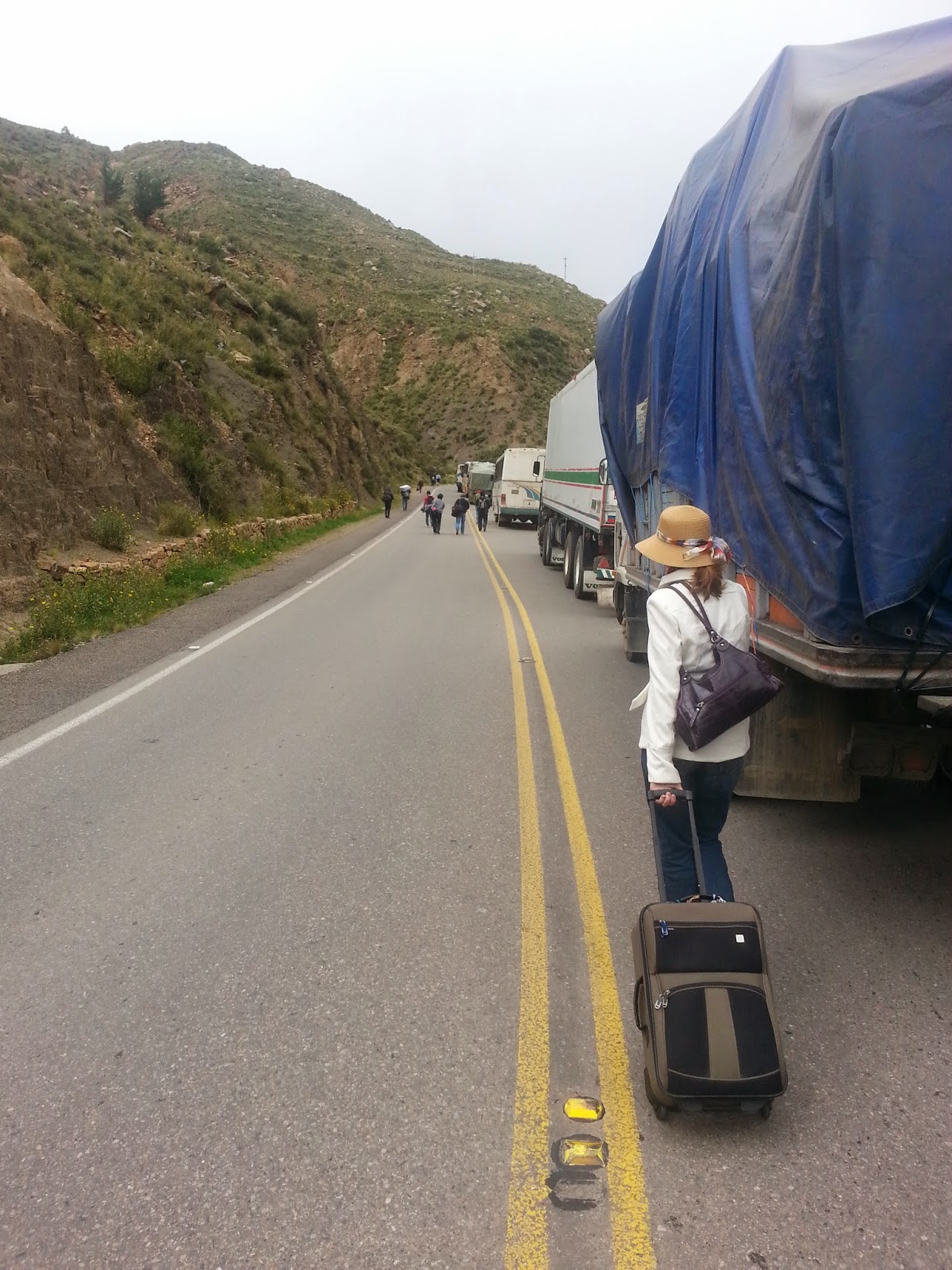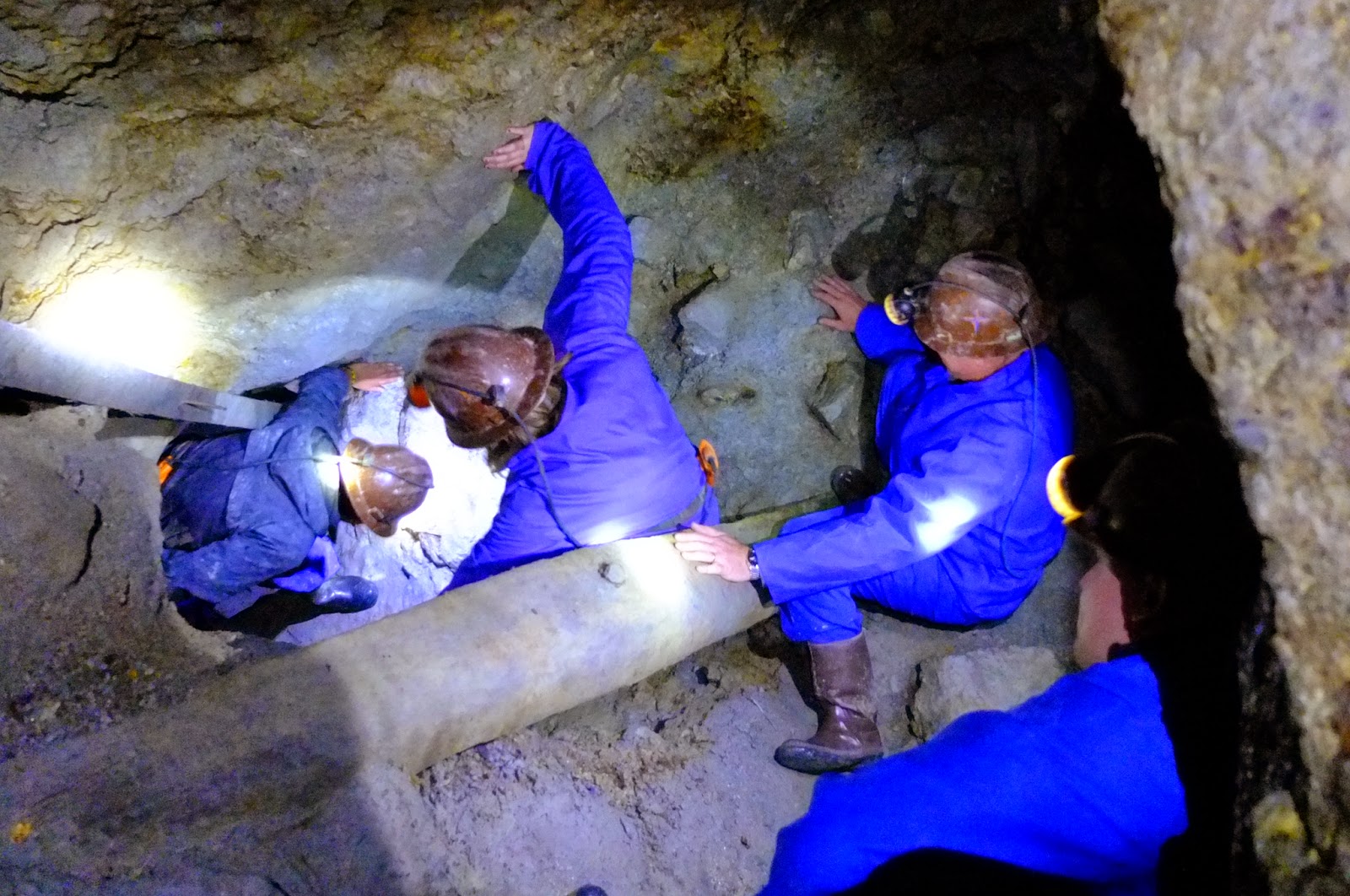We got to enjoy our first Bolivian wedding last month. Rachel, Yovi and Yolanda got the joy of preparing chocolate covered fruit platters, Bolivian meatballs and salsa, and deviled eggs (something Bolivians have never heard of) as appetizers. There were 22 tables and 220 guests. It was a hectic couple of days preparing but you can see the tasty results below.
 |
| Gorgeous wedding reception venue |
 |
| Some of the appetizers |
 |
| Sisters preparing appetizers |
Our trip to Potosi
Our friends from England recently found out they cannot renew their VISAs. They will be returning home by the end of March. Once again we our losing our friends. Thus we decided to go to Potosi to bid them adieu, adios, farewell, sayonara, aufwiedersehen, ciao ... BUT ... it wasn't clear skies and beautiful scenery all the way there.
 |
| highway to Potosi |
 |
| highway to Potosi |
 |
| Hiking up to Potosi |
 |
| Miners blockaded the highway |
We hit a rock in the road ... or should I say many rocks ... as we got closer to Potosi. In Bolivia it is common for disgruntled people with complaints to block the highways - called 'bloqueados'. On this occasion it was the miners who had a beef. Fortunately, unlike the violent bloqueados of the past, there was no pelting with rocks of persons crossing the blockade. Perhaps it was the large police presence that deterred them?!?! Still it was quite the half hour hike up the hill, especially considering the 14,000 foot elevation!
After arriving and getting settled in we decided to take a mine tour of Cerro Rico, the infamous mountain of Potosi (g96 8/8 p20-21). Legend says that they could build a bridge from Potosi to Spain with the silver they extracted. The horror of the story is that they could also build a bridge of the same span with the bones of all those who have died extracting the ore, mainly native indigenous and African slaves who were forced to work in the mines.
A custom for those visiting the mines is that they stop at local merchant shops to buy gifts for the miners. The usual gifts are bottles of 96% alcohol, coco leaves, water, cigarettes and dynamite. Miners don't eat while in the mines, they just chew coco leaves and drink alcohol for energy. This reduces the need for washroom breaks. They also need to supply their own dynamite. They only receive a pay check if they find valuable ore. Thus it is understandable why it is customary for tourists to bring them gifts.
Potosi also happens to be one of the only areas (perhaps THE ONLY) where you can buy dynamite without a permit or providing any documentation or identification at all. Even children can buy dynamite. We couldn't resist the urge! When will we get the opportunity to buy and detonate dynamite again?
One shocking surprise, as we sat in the 'tienda' our guide unwrapped a stick of dynamite and had us hold it. It felt like sticky play dough with a fish smell. While we passed it around Marco lit a match and slid it along the dynamite in our hands!!! Apparently a chemical reaction with the mercury in the blasting cap (or primer) is what causes the dynamite to explode. It would have been nice to have that explained before the match was placed next to the stick of unwrapped dynamite!
 |
| ready to blow! |
 |
| Dynamite |
 |
| Buying dynamite |
Not far inside the cave entrance is a large, human sized idol of 'Tio'. Tio is the Spanish word for uncle but it's origin in the case of the idol is from the Kechua peoples attempt to say the Spanish word for God, 'Dios'. Apparently Kechua does not have a sound for D thus attempts to say Dios came out as Tio. The Tio idol was a disgusting red devil with a giant penis. Upon entering the cave the customary way to appease his anger and have his blessing in making the mountain fertile is by putting coco leaves on the idol, pouring alcohol on it and lighting a cigarette and sticking it in his mouth. As long as the cigarette is burning you have his permission to enter. The people are a lot like their gods in their habits. What a protection for our health that we worship the clean god!
 |
| Best looking mining crew in Potosi |
 |
| rest tunnel with altar |
Inside the tunnels we ascended and descended to various parallel mine-shafts at different elevations. The smooth clay lining the shafts made this a little dicey. At times we took turns helping place each others feet onto the rough hewn steps. Occasionally we would get distracted by the veins of minerals glistening above us, but only for a moment or two as we would end up tripping over the uneven muddy ground if we didn't pay constant attention to where we placed our feet.
A couple of times we stopped to rest in small, dead end, side tunnels. The first time we stopped to get a lesson on how to place and pack dynamite. The second time to safely wait in a side tunnel for the dynamite to be exploded. It was an eerie feeling to hear the 'thwump' of the explosion and have a rush of air push past us. It reminded us of the impact tremors felt during Jurassic Park during the first scene with the T-Rex. Yes, this is an active mine that we were touring.
Waiting and conversing with the miners we got to find out many of the details of life as a Bolivian miner. It is definitely not a safe or easy job! All along the walls of many tunnels there are small, crystalline, snow-flake like or fiberglass like coatings. This, we found out, is arsenic. Miners here don't wear protective breathing masks. They sometimes can be seen pulling their sweaters up over their mouths when it is really dusty. Thus one danger for miners is dying of silicosis, a lung disease from breathing the airborne arsenic and silica minerals. To test for bad air down the tunnels they throw a juicy orange. They check it 4 or 5 hours later. If it has dehydrated then they know air quality is dangerous and they avoid that tunnel.
 |
| Lesson on how to place dynamite |
 |
| descending to a lower mineshaft proved a little sketchy |
They also have to push the full ore carts weighing 2 tonnes out of the mine by hand. As you can imagine this is labor intensive work.
 |
| Full ore cart - from the angle you can tell it "jumped track" |
One of the following days we took a small trip to the "Ojo del Inca", a natural hot spring the size of a small pond. It was apparently a cone shaped pond that was 22 meters deep at the center and heated by volcanic lava. Don't worry we stayed near the edges ... most of the time.
 |
| Swimming at Ojo del Inca |
 |
| Our friends whom we're going to miss! |
Service Update
Just a small experience from our Public Witnessing Cart. It has proven to be VERY effective for contacting people. By the middle of March my placements (just mine and not Rachels), great thanks to our increased Public Witnessing, were 131 mags, 17 brochures and 217 tracts / invitations. We try not to put books on our cart as they are placed just as fast as the other literature. We keep them hidden at the back and offer them to people who request bible studies.
On that note, one of the Public Witnessing referrals we received was a family of 3 teenage girls who requested a study. We have met 2 of the girls and from our first visit onward (once we found their house ... arrrgghhh) we have had a very nice, productive bible study in the Bible Teach book. It seems Jehovah is really blessing this form of the ministry here in Bolivia.
 |
| Sharing Caleb during a rest break |
 |
| Getting mobbed while Public Witnessing - in a good way! |
You may wonder how we get such success here (other than the fact that the average person has a deep respect for and interest in the bible)? Well, it's because we show videos while we're Public Witnessing. Usually we show Caleb or whiteboard animations. This draws crowds of kids. Often, even if they don't stop, we hear them saying to their parents "look mom, it's Caleb". This warms our hearts seeing how effective these videos are at reaching the young ones and how well known they are here in Oruro. When the children come we often try to give them just a tract. Many won't leave until they get a magazine or brochure. We keep a supply of old magazines for the children and limit them to one per family. Often though, they will go away and get their parents to come back with them to request more literature and/or forms of literature that we don't allow children to take. Yes, the videos sure are an effective tool and blessing from our dear brothers taking the lead in the organization!
Everyday Life
Everyday life still holds it's challenges. Our recent battles have been with insects. For the last few months sugar ants have slowly increased in numbers in our house. We ignored them as we didn't know where to go to buy 'ant bait'. Then one day we noticed very fine saw dust under our bed. Wanting to locate the source I lifted the mattress and box spring onto their side. There was a lot of saw dust on the inside of fabric stapled to the bottom of our box spring. Peeling that back revealed a colony of termites actively eating our bed right out from under us!
So that whole day was blown buying diesel (the recommended poison for termites here in Bolivia) and spreading it all over the wood support structure of our box spring, walking all over downtown looking for ant bait and cleaning up the mess made by it all.
Know what the worst part was??? We bought the mattress NEW!!!! And we paid an exorbitant price! This was literally the most expensive bed we have ever purchased. Partly because they overcharge extranjeros (foreigners) and partly because Canadian style beds are still not common in Oruro (many still sleep on straw mattresses covered in the same material from which rice sacks are made). And we are still sleeping with our mattress on the floor as our boxspring is banished to the hallway until the overpowering smell of diesel dissipates. Oh well, as our friends often say; "TIB" (this is Bolivia).
The other challenge is the cold. I'm not sure when summer was supposed to have arrived, but apparently it is over. Last night was -3 Celsius and we were greeted by heavy rain during the morning. Apparently the rains will dry up this month. But with the reduced cloud cover the temperatures will continue to drop from the the balmy day time highs of 16 Celsius to the frigid barely above 0 Celsius that is our winter. Of course, if we stand in the sun we can still get burnt! So there is a positive!
Well that's all for now. Keep warm and well fed. Yes this has new meaning for us and we really wish that for all of you. Lots of love. Over and out.